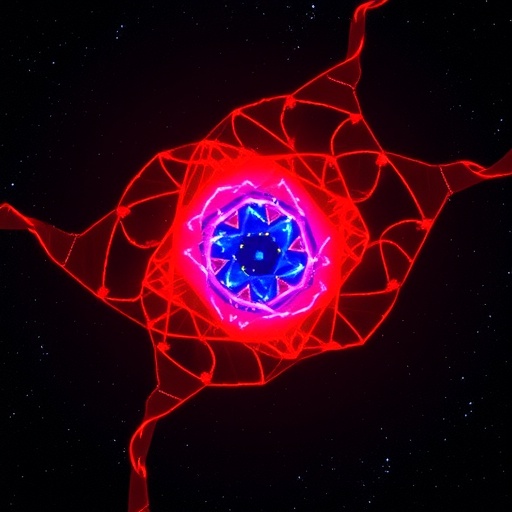A groundbreaking advancement in image analysis technology is poised to transform how medical professionals, environmental scientists, and researchers approach detection challenges in complex visual data. Developed by a team of University of British Columbia Okanagan (UBCO) students under the mentorship of Associate Professor Xiaoping Shi, this new model — the adaptive multiple change point energy-based model segmentation (MEBS) — harnesses sophisticated mathematical frameworks to address longstanding limitations of image segmentation in diverse, noisy contexts.
At its core, MEBS represents a leap forward by incorporating adaptive capabilities that enable it to recognize and segment images where traditional methods fall short. Most existing segmentation tools apply fixed rules or assumptions about data characteristics, often tailored for ideal or Gaussian noise environments. However, many real-world images, such as medical scans or satellite captures, contain non-Gaussian noise and irregular patterns that stymie conventional approaches. The novelty of MEBS lies in its ability to dynamically adjust to these atypical features, improving detection fidelity without manual recalibration.
The underlying mathematical principles of MEBS are rooted in energy-based models combined with multiple change point detection techniques. This synergy allows the system to autonomously pinpoint shifts in image properties, such as intensity or texture, that signify boundaries or regions of interest. By modeling these shifts as change points, MEBS segments images more accurately, especially when dealing with subtle or ambiguous structures often masked by noise. This approach is particularly important for medical imaging, where precise delineation of tumours or fluid accumulations can critically affect diagnostic outcomes.
In practical applications, MEBS’s adaptive segmentation capability enables healthcare providers to detect abnormalities in X-rays and mammograms with enhanced clarity. The model’s sensitivity to nuanced changes translates to earlier and more reliable identification of tumours and pathological fluid buildups. This advancement stands to significantly augment diagnostic workflows by reducing false negatives and enabling more targeted treatment planning, ultimately improving patient outcomes.
Environmental monitoring similarly benefits from the precision of MEBS. Wildfire management, a pressing concern exacerbated by climate change, demands rapid detection of nascent hotspots to mobilize containment efforts effectively. The adaptive model’s facility to parse satellite images laden with atmospheric noise allows it to detect small yet critical ignition points with unprecedented speed. Such capability promises to revolutionize how wildfire data is processed and applied in real-time crisis management.
Beyond health and environmental science, MEBS also offers substantial utility in biological research, particularly in plant biology and agricultural domains. Accurately counting and tracking cellular growth patterns is essential for understanding developmental processes and optimizing crop yields. Traditional imaging tools frequently struggle with cell segmentation when confronted with variable lighting or heterogeneous tissue samples. MEBS’s energy-based adaptive segmentation provides robust solutions to these challenges, enabling researchers to gather precise data that informs genetic and agronomic advancements.
This innovative technology’s development was driven by a dedicated team of UBCO students — including lead author Jiatao Zhong, along with Shiyin Du, Canruo Shen, Yiting Chen, Medha Naidu, and Min Gao — who collaboratively undertook the tasks of coding, experimentation, and validation. The students’ contributions showcase the synergy between academic mentorship and student initiative, providing a practical learning environment that bridges theoretical mathematics and applied data science.
The research effort was also bolstered by collaboration with Dr. Yuejiao Fu, further enriching the multidisciplinary nature of the project. Together, the team rigorously tested MEBS across various datasets representing real-world complexities to validate its performance gains over existing segmentation techniques. This comprehensive evaluation underscores the model’s versatility and adaptability in different domains.
The significance of MEBS lies not only in its academic novelty but also in its practical implications. Automatic adaptation to the inherent irregularities of images eliminates the need for extensive manual tuning, which is often time-consuming and prone to human error. This feature facilitates scalable application across industries where data volume, diversity, and quality vary widely, from hospitals to space agencies.
Funded by the Natural Sciences and Engineering Research Council of Canada and UBC Okanagan’s Vice-Principal, Research and Innovation office, the project exemplifies the vital role of institutional support in driving frontier scientific research. The outcomes pave the way for future explorations into energy-based methods and adaptive algorithms that can further elevate the capabilities of image processing technologies.
Published in the esteemed journal Scientific Reports in July 2025, the MEBS study not only pushes forward the boundaries of image segmentation but also resonates with a broader scientific community eager for solutions to complex pattern recognition problems. It reflects an exciting intersection of applied mathematics, computer science, and environmental and health sciences that is set to inspire subsequent innovations.
MEBS stands as a testament to how interdisciplinary collaboration and advanced mathematical modeling can produce tools with profound real-world impact, providing a new lens through which scientists and practitioners can extract meaningful insights from the most challenging visual data.
Subject of Research: Not applicable
Article Title: Energy-based segmentation methods for images with non-Gaussian noise
News Publication Date: 16-Jul-2025
Web References:
https://www.nature.com/articles/s41598-025-09211-8
References:
DOI: 10.1038/s41598-025-09211-8
Keywords:
Complex analysis, Computer science, Applied physics, Applied mathematics, Energy resources, Industrial science, Information science, Network science, Technology




